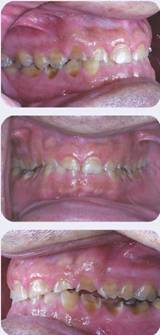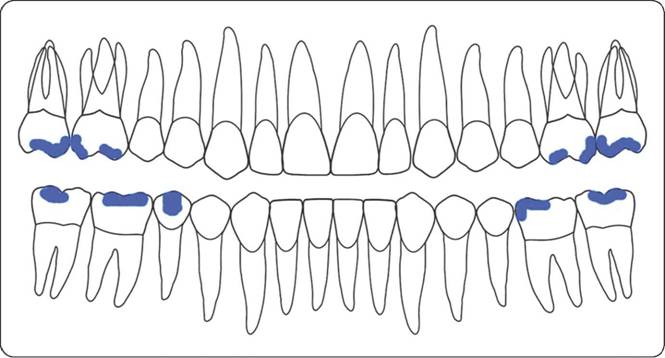
Management of worn dentition III—generalized severe wear
CASE STORY
A 42-year-old male patient presents with a chief complaint of). “I am not happy with the way my teeth look.” Intraoral examination reveals extreme wear of multiple surfaces of most teeth in the patient’s maxillary and mandibular jaws. The patient denies any history of gastroesophogeal regurgitation of any kind. After several interviews to determine the etiology of the patient’s dental condition, it is revealed that the patient drinks excessive amounts of soft drinks and swishes the soft drinks in his mouth.
Figures 1 and 2: Pretreatment occlusal views.

Figures 3, 4, and 5: Pretreatment maximum intercuspation.

Clinical Cases in Prosthodontics, Leila Jahangiri, Marjan Moghadam, Mijin Choi, and Michael Ferguson, © 2011 Blackwell Publishing Ltd.
LEARNING GOALS AND OBJECTIVES
- Determining etiology of severe and unusual tooth wear
- Association of dental erosion and acidic soft drinks
Medical History
- No significant findings
Dental History
- History of operative dentistry—amalgam restorations on posterior dentition
Medications and Allergies
- No medications
- No known drug allergies
Review of Systems
- Vital signs:
- Blood pressure: 120/80
- Heart rate: 74 beats/minute
- Respiration rate: 16 breaths/minute
Social History
- No history of bulimia
- No history of alcohol, tobacco, or drug abuse
Significant Soft Tissue Examination Findings
- No significant findings
Charting
(See Fig. 6.)
Figure 6: Dental charting.

Significant Clinical Findings/Problem List
- Erosion of occlusal/incisal/buccal surfaces of the following teeth:
- Maxillary right and left first molars (3 and 14)
- Maxillary right and left first and second premolars (4, 5, 12 and 13)
- Maxillary right and left canines (6 and 11)
- Maxillary incisors (7, 8, 9 and 10)
- Mandibular left and right first and second molars (18, 19, 30 and 31)
- Mandibular left and right first and second premolars (20, 21, 28 and 29)
- Mandibular left and right canines (22 and 27)
- Mandibular incisors (23, 24,25 and 26)
- Caries: mesial surface maxillary right first premolar (5)
Figure 7: Bitewing radiographs.

Diagnosis
- Severe erosion
- Caries
Clinical Decision-Making Determining Factors
- Dental erosion is described as loss of tooth structure as a result of a chemical process that can involve instrinsic and/or extrinsic factors (described below). The process does not involve a bacterial component. Depending on the chemical process involved in the erosive process, different erosive patterns can be seen. For example, erosion from chronic regurgitation (as is the case with bulimia) typically results in erosion of the lingual surfaces of the maxillary teeth, especially in the anterior region. The patient described here presents with severe erosion of the following areas:
- Incisal surfaces of the maxillary and mandibular anterior teeth
- Lingual surfaces of the maxillary anterior teeth
- Occlusal surfaces of all posterior teeth (except maxillary second molars)
- Buccal surfaces of the maxillary premolars
- Buc/>
Stay updated, free dental videos. Join our Telegram channel

VIDEdental - Online dental courses


